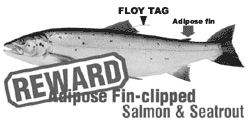| Results from the Spey Fishery Board’s catch and release tagging project indicate that on average 9.5% of the spring salmon caught and released before the end of May 2000 and 2001 were recaptured a second time. However, there was a considerable difference in the re-capture rates between the two seasons. During 2000 16% were re-captured while in 2001 only 7% succumbed to the angler’s lure. Due to this discrepancy the Board is continuing the tagging project for the 2002 season. The recapture rates for salmon and grilse tagged after May were much lower at only 0.3% over the two seasons, emphasising the relative vulnerability of spring salmon to angling. The study also highlighted an improvement in anglers’ attitudes to conservation. In 2000 only 25% of the re-captured salmon were released but in 2001 this had improved to an encouraging 70%. Re-capture locations were generally upstream from the release point, with the longest migration completed by salmon B212. This “springer” was tagged at Arndilly on 9th April 2001 and recaptured in the River Truim near Dalwhinnie on 17th September 2002, having travelled a distance of 95km! Re-captures of this kind have contributed greatly to our understanding of the migrations and eventual spawning areas of the different stocks in the Spey. The migration of salmon B212 concurs with our findings from radio tracking in the late 1980s and illustrates the importance of the upper tributaries as spring salmon rearing areas. Most tagging studies have a fish which doesn’t quite fit the expected pattern and summer salmon (O134) was the odd one out in this study. It was initially captured and tagged at Castle Grant during July but after a couple of months it re-appeared in early September 33km downstream at Rothes! The re-captured salmon was in good condition and the angler subsequently released it to continue its journey. Where it finally spawned is anyone’s guess. Tagged Fish Anyone catching an adipose fin-clipped or Floy Tagged fish please contact the SPEY RESEARCH TRUST – (01340) 810841. A reward together with details of tagging will be sent for each tagged fish notified. Adipose Fin Clipped Salmon and Sea Trout
A number of wild and hatchery reared juvenile salmon and trout have a small micro-tag (1 mm) implanted in their nose each year. These micro-tags are not visible so the adipose fin is removed to identify the returning adults. What to Do Floy Tagged Salmon A catch and release project is underway on the Spey and salmon carrying a floy tag have been previously caught and released within the river. What To Do Tagging projects are generously supported by: |
Welcome!Log into your account












